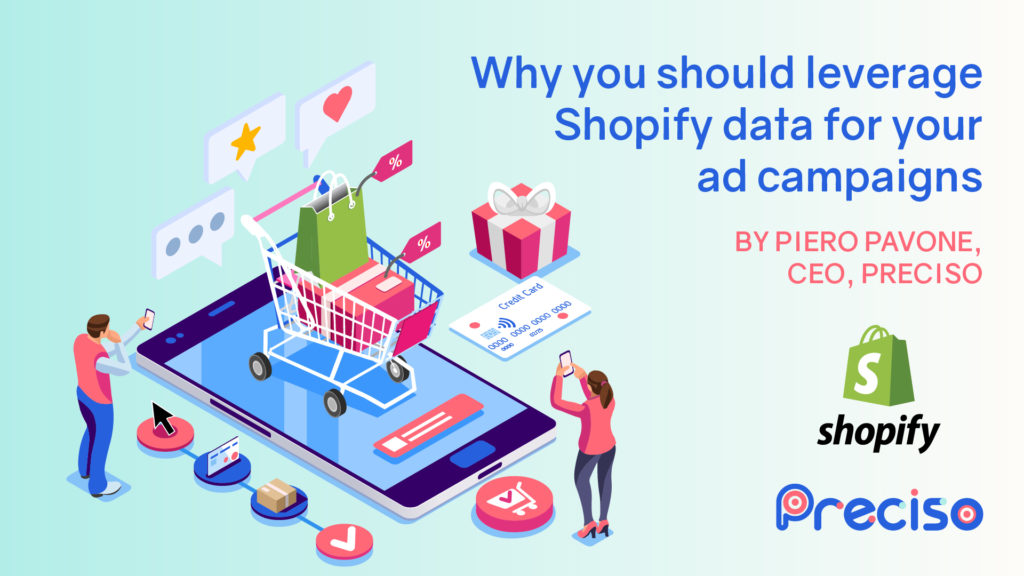By Piero Pavone, CEO, Preciso
Shopify is a huge name in ecommerce. The business itself increased its total revenue by 22% to $1.4bn in Q3 2022, and is seeing a three-year compound annual growth rate (CAGR) of 52%. This increase in growth is largely fuelled by its global multi-million network of merchants, processing an average of 152.6m orders per month.
But why is Shopify so popular? And how can your business take advantage of what it has to offer when it comes to building your ad campaigns?
Why Shopify provides a great experience for SMEs
Beyond being a big name in the ecommerce space with a good reputation (which naturally leads to higher customer trust), there are a number of practical reasons why Shopify is at the forefront of ecommerce, especially for SMEs using the platform to host their online stores.
All the integrations you’ll ever need
As Shopify says, they “cover the basics every business needs. For everything else, there are apps”. These integrations make running an ecommerce business on Shopify simple, customisable, scalable – and ultimately – profitable. As your business grows, you can draw on different apps to optimise your approach.
Shopify has various different APIs available for Admin, Storefront, Partner, Payment Apps, Marketplaces, and Messaging – with public documentation and templates for developers to use. As a result, Shopify has thousands of app integrations in its app store – including Preciso’s own, which offers plug-and-play targeted display ad campaigns, specifically for SMEs.
More data available
Many newer businesses make the mistake of advertising with too general an idea of who to target, based on business and/or marketing plans or a few preliminary campaigns. But as your online store begins to grow, so does the data you gather on your customers, which you can use to narrow the target audience for your ads.
With Google sunsetting third-party cookies by the end of 2024, it’ll be more important than ever to maximise the first-party data your business gathers – which Shopify can help you do.
Shopify is a global provider
Shopify is, of course, not the only global commerce platform of its kind – Magento, WooCommerce and BigCommerce are among the other significant players. But it is the largest, with more than 2 million merchants distributed across more than 170 countries around the world. Broken down geographically, 55% are based in North America; 25% in EMEA; 15% in APAC; and 5% in LATAM. Therefore, wherever you are on the planet, chances are you’ll be able to set up a Shopify store and grow an online business.
Many of the Shopify app store integrations are also free, which means you save on expensive development time if you build a self-hosted store with similar integrations.
Using app integrations to leverage Shopify data
Many small business owners, even those with an active online presence, may be unfamiliar with the nuances of programmatic advertising, and especially with advanced solutions such as ‘smart bidding’, which uses automated technology to secure the best possible media/advertising space for a brand.
Large enterprises often rely on programmatic to boost impressions and click-through rates, which in turn can dramatically boost campaign Return on Ad Spend (ROAS).
However, it is difficult for smaller enterprises to take advantage of the same programmatic options. Programmatic ad agencies often require a large minimum ad spend budget to get started, and this typically excludes new and small businesses.
However, when you use Shopify for your online store, you naturally gather huge amounts of first-party data you can use for advertising – and a smart-bid integration can enable merchants to use programmatic technology to maximise the potential of their data – even with smaller budgets.
Within a few clicks, you can gain access to advertising algorithms and ranking systems that help get your message to the right audiences, at the right time – all without wasting your ad budget on the “pay and pray” approach to setting an ad budget (for example, using “promote” buttons on social media).
And that’s why, by combining smart bidding integration tools with the vast audiences that Shopify has to offer, brands of all sizes can start to leverage the benefits of the ecommerce giant and maximise their ROI beyond all expectations.












